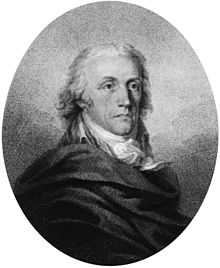Johann Adam Schmidt
 | |
| Born |
12 October 1759 Aub |
| Died | 19 February 1809 |
| Nationality | Germany |
| Occupation |
surgeon ophthalmologist |
| Known for | iritis |
He began his medical career as an army Unterchirurg (under surgeon), and later studied ophthalmology under Joseph Barth (1745–1818) in Vienna. In 1795 he became a professor at Josephs-Akademie in Vienna, where he gave lectures on several subjects in medicine.
He performed pioneer research of iritis, and in 1801 was the author of a significant work on the disorder titled Über Nachstaar und Iritis nach Staaroperationen (On Post-Cataract and Inflammation of the Iris following Cataract Surgery).[1] In 1802, together with Karl Gustav Himly (1772–1837) he founded Ophthalmologische Bibliothek, which was the first German magazine of ophthalmic medicine. In 1811 his Lehrbuch der Materia Medica was published posthumously, which was a work on medicinal plants and their properties. In this book the term "pharmacognosy" is originally coined.[2]
Schmidt is best remembered as a personal physician of Ludwig van Beethoven, whom he attended to from 1801 until 1809.[3] Beethoven dedicated the trio for piano, violin and cello in E-flat major opus 38 (arrangement of the Septet opus 20) to Schmidt.
Works
- Johann Adam Schmidt's Handschriftlich hinterlassenes Lehrbuch der Materia medica . Kupffer & Wimmer, Wien 1811 Digital edition by the University and State Library Düsseldorf
References
- ↑ Daniel M. Albert (29 October 2002). Dates in Ophthalmology. Parthenon. pp. 64–. ISBN 978-1-84214-113-7. Retrieved 16 April 2012.
- ↑ Michael Heinrich (2004). Fundamentals of Pharmacognosy and Phytotherapy. Elsevier Health Sciences. pp. 19–. ISBN 978-0-443-07132-4. Retrieved 16 April 2012.
- ↑ Krogmann, Frank; Vollmuth Ralf (2009). "An important son of Aub: the military surgeon and ophthalmologist Johann Adam Schmidt (1759–1809)". Wurzbg Medizinhist Mitt 28: 353–74. PMID 20509447.
External links
- Ludwig van Beethoven's Biography
- translated biography @ Allgemeine Deutsche Biographie
See also
|